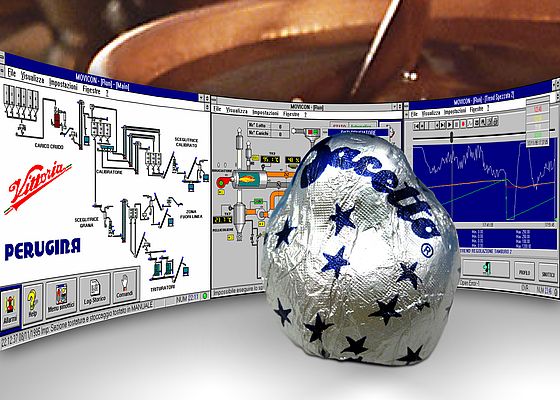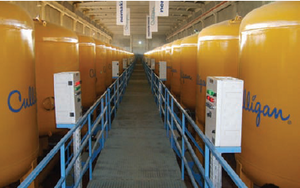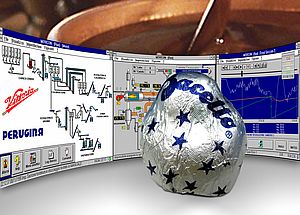By integrating a SCADA system into its ‘Baci’ chocolate production line, Nestlè in Perugina is now able to plan and optimise production batches, analyse product output with report printouts, historically log the roasting result for each batch of hazelnuts, and deploy the widest range of commands for running the plant in either automatic or manual mode.
The storage, roasting and hazelnut conveyor management system has been designed and installed at Nestlè Perugina’s plant by VITTORIA-COMARK, a specialist in the food sector, in collaboration with Coteco srl, a Movicon SCADA system distributor and integrator, based in north Italy.
The system has two distinct parts. The hazelnut roasting machine, which is at the heart of the plant, is an independent unit managed by an Allen-Bradley PLC and an industrial PC, with Movicon supervision system. Communication between the PC and PLC is via the Allen-Bradley DF1 serial protocol. The plant itself comprises a raw material storage and loading section, a roasted discharger and calibrator section, a chopping section and production line transfer section. This is also managed by an Allen-Bradley SLC500 PLC and a standard PC with the Movicon supervisor onboard. Control of the plant sections is via Machine PLCs that communicate over a “Data Highway” network with an analogue PLC incorporated to manage the system.
The hazelnut roasting machine is the most fundamental and critical part of the production process. In addition to supervising the operation of the machine in real-time, the Movicon management system also has the task to set and optimise production data in the best, intuitive and simplest way possible. Using the Windows environment greatly simplifies these tasks, being a consolidated standard for all users.
The Movicon supervision system is completely configurable, providing great flexibility and adaptability to all production requirements. It is very easy to use, allowing quick and intuitive setting of work parameters, through dialog windows, which can be activated using the appropriate buttons, or via a simple mouse click on screen. For example: a simple click on the burner will activate a window for setting its temperatures and alarm thresholds. This same procedure is also used for setting commands manually. By clicking on the desired motor, or valve, on screen a dropdown menu appears, for starting or stopping of plant devices. Purposely designed with user-friendliness in mind, the Movicon system enables commands to be set in the most natural and intuitive way possible. It also provides additional support in the form of help windows, which can be customised and adapted as ‘pop-ups’.
Production management
As a result of employing modern technology, based on PCs with Windows-based SCADA, operators at the Perugia plant can now set automatically, and across the entire production process, batch sequences that are completely different from each other, at the same time. By choosing Movicon as a management system, the client has reduced development times by being able to set all the data necessary for automatic plant production processes, production profiles and batches by simply using dialog windows. Operators can enter a set of values for each type of nut to be roasted in order to regulate temperatures in the roasting drums.
A step-by-step sequence can be created whereby each drum can be set with specific temperatures, time durations and the associated P.I.D. control type. This step sequence forms the ‘fingerprint’ of the product roasting profile. To get a clearer picture of each roasting profile, the operator can analyse graphs on screen showing the behaviour of each roasting profile set. Each profile can be recorded on file as a normal recipe. This enables the user to create new recipes or activate and modify those already saved on file by using the appropriate dialog window, relating to the recipe, using the Windows standards.
System management
The second Movicon equipped PC is situated in the Control Room, and linked to a second Allen Bradley SLC 500 PLC. These units provide the Systems Management element of the project. They receive data from the roasting machine section’s PC-PLC system, relating to the raw product dispatch and the roasted product line transfer. The system management’s task, subdivided into sections, is to satisfy the roasting machine requirements as set out in the production plan. The “raw section” is designated the task of storing the raw nuts in the right silos according to product type. The product is then sent, in batches, from the raw storage silos to the drums, upon machine request, for roasting according to the preset roasting profile activated. When completed, the roasted product is then transferred to the “calibrator section”, preset with the nut selection type, then to be stored in the appropriate silos in the “roasted section”, according to nut type.
Monitoring and control
The various plant sections are controlled and supervised using Movicon video screen pages. By using these screens, operators are guided throughout the whole production process with simple and attractive animated graphics. The plant’s real time status is captured by illuminated or colour changing icons and motor status and alarm indications. Particular care has been taken to ensure the graphics are realistic by optimising them with animated conveyor belts, agitator, feeder and burner movements in real time. As a result, operators can clearly observe the progress of a product through each stage of its process cycle.
Both Movicon supervisory systems allow easy diagnosis, machine and system maintenance, by using a complete alarm and message management in accordance with the ISA standard. All the significant alarms and events (messages or self-diagnosis) are recorded on database files, which can be displayed and viewed in the Historical Log window or printed on request. The Movicon supervisor allows customisable historical management, enabling recording to take place only when needed (on event or established by the control logic) in order to optimise the analysis process without wasting memory space.
SCADA system provides supervision
for confectionary manufacturer
- by Progea Srl
- April 26, 2013
- 416 views



















